Stomach Hernia Discomfort Signs And Symptoms After Consuming: Why It Takes Place And Just How To Manage It

Personnel Author-Moore Field
If you have actually experienced abdominal hernia discomfort after consuming, you're not the only one. This pain usually occurs from the pressure on a weakened location of your abdominal wall surface during digestion. You might see sharp or aching pain, bloating, and even a noticeable lump. Yet what can https://mgyb.co/s/KJdBc do to manage these symptoms? Understanding the connection between hernias and post-meal pain is the initial step toward locating alleviation. Let's explore this better.
Recognizing the Web Link In Between Hernias and Post-Meal Pain
When you eat, your body goes through an intricate process of food digestion that can occasionally trigger pain if you have a hernia. This takes place since a hernia happens when an organ or cells bulges through a weak point in the abdominal wall.
As food moves through your gastrointestinal system, it might tax this weakened location. You might really feel pain or pain, specifically after eating larger dishes or details foods that create bloating.
Furthermore, the motion of your intestines during food digestion can exacerbate the hernia, leading to a lot more extreme experiences. Recognizing this connection is important, as it aids you determine potential triggers and make nutritional changes to manage pain effectively.
Keeping track of what you eat can supply beneficial insights.
Common Symptoms of hernia Pain After Eating
If you have a hernia, you might discover details signs and symptoms after consuming that signal discomfort. Commonly, you may experience sharp or aching discomfort in your abdominal area, particularly around the hernia site. This pain can escalate after meals, particularly if you have actually eaten a big part or heavy foods.
Bloating and gas are also frequent issues, making you really feel uncomfortably full. simply click the next web page might also observe a noticeable bulge in your abdominal areas that comes to be more pronounced post-eating.
Nausea and occasional vomiting can happen, particularly if the hernia is triggering a blockage. If you find yourself experiencing these signs and symptoms regularly after meals, it's vital to consult a healthcare professional for appropriate examination and guidance.
Approaches for Taking Care Of hernia Discomfort After Meals
To handle hernia pain after meals effectively, think about making some nutritional and way of life adjustments.
Start by consuming smaller, a lot more regular meals instead of large parts, which can lower stress on your abdomen. Concentrate on low-fat, high-fiber foods to alleviate food digestion. Avoid spicy, acidic, or fried foods that might cause pain.
On top of that, preserve a healthy and balanced weight to lessen stress on your abdominal wall surface.
After eating, attempt to continue to be upright for at least two hours to help food digestion; this can aid prevent pain. Gentle tasks like walking can likewise advertise digestion, but stay clear of intense workout promptly after dishes.
Staying hydrated is vital-- beverage lots of water throughout the day to sustain gastrointestinal health and wellness and general wellness.
Final thought
Finally, if you're experiencing abdominal hernia pain after consuming, it's crucial to recognize the link between your diet regimen and your signs and symptoms. By taking on smaller sized, much more constant meals and staying clear of trigger foods, you can significantly decrease discomfort. Staying upright and engaging in light activity post-meal can additionally help. Don't hesitate to get in touch with a health care professional if your symptoms persist. Taking these steps can improve your comfort and enhance your overall well-being.

